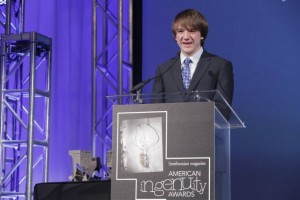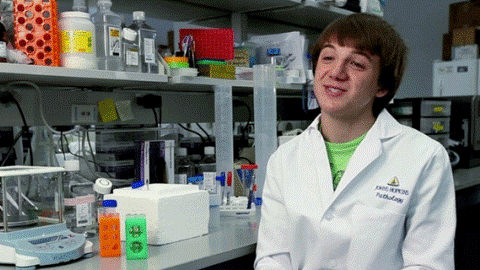When you were 15, chances are, revolutionizing medicine wasn’t among your after-school activities. But for 15-year-old Jack Andraka, it’s par for the course. The high school sophomore recently developed a revolutionary new test for early-stage pancreatic cancer. This, before he could legally drive a car.
 This past December, Andraka won Intel’s prestigious Gordon E. Moore Award along with other top honors at the corporation’s annual Science and Engineering Fair, the world’s largest high school research and science competition. Jack Andraka created a simple dip-stick sensor to test for levels of mesothelin, which is a biomarker for early-stage pancreatic cancer that’s found in blood and urine. The method is similar to diabetic testing strips, utilizing just a pinprick of blood and costing all of three cents to make.
This past December, Andraka won Intel’s prestigious Gordon E. Moore Award along with other top honors at the corporation’s annual Science and Engineering Fair, the world’s largest high school research and science competition. Jack Andraka created a simple dip-stick sensor to test for levels of mesothelin, which is a biomarker for early-stage pancreatic cancer that’s found in blood and urine. The method is similar to diabetic testing strips, utilizing just a pinprick of blood and costing all of three cents to make.
Jack Andraka was moved by the frustrating realities of pancreatic cancer, a particularly lethal form of the disease, after a family friend passed away from it. But it wasn’t until he was sitting in class sometime later that a solution struck him. Andraka tells TakePart, “I came up with the idea when I was in science class. I was supposed to be paying attention, but then I had this epiphany.”
What’s so revolutionary about Andraka’s epiphany, aside from possibly being the most inexpensive medical test ever devised, is that current methods for pancreatic cancer detection are woefully ineffective—for the most part, they’re unable to uncover the presence of the disease until it’s in its final stages, long after it could respond to treatment. That’s why the American Cancer Society reports that on average, the one-year survival rate for a patient is just 20 percent, and the five-year rate is a dismal four percent.
However, Andraka’s prize-winning invention means patients could be armed with a simple method to detect the disease in its earliest incarnations, before it becomes invasive and when it still has a chance to respond to medical care. Early detection could bump up survival rates dramatically, edging them “close to 100 percent” according to Andraka. And for a disease that takes the lives of approximately 40,000 people each year, that’s saying a lot.
But this is about more than pancreatic cancer. Andraka explains his strips can be altered to detect biomarkers for other conditions as well. “What’s so cool about that is its applicability to other diseases…for example other forms of cancer, tuberculosis, HIV, environmental contaminants like E Coli, salmonella,” he says. “All for three cents for a test that takes five minutes to run.”
He has big plans to turn the medical community on its ear by mass marketing his work, making it widely available. He says, “Essentially what I’m envisioning here is that this could be on your shelf at your Walgreens, your Kmart. Let’s say you suspect you have a condition…you buy the test for that. And you can see immediately if you have it. Instead of your doctor being the doctor, you’re the doctor.” The teenager reports that he’s already in talks with major corporations like LabCorp and QuestDiagnostics to bring his kits to store shelves “as soon as possible,” though how long that may actually take isn’t yet known.
But if it seems like everything comes easily to the Maryland student, don’t be fooled. While in the process of soliciting area labs for research space, he was rejected by 197 scientists, some of whom told him quite plainly his theory couldn’t possibly work. Only one person said yes, but it turned out to be the right person—Dr. Anirban Maitra, a professor of pathology and oncology at Johns Hopkins University, who also became Jack’s mentor.
It’s easy to chalk up Jack Andraka’s success to the luck that comes with being brilliant—he is ridiculously smart. But there’s more to him than that. His innate sense of social justice tells him that in a country as developed as ours, the fact that we have so many people dying every day of what could be a treatable disease is a wrong he intends to make right. “What motivates me is that 100 people die every day from pancreatic cancer. And so when I’m working I think those 100 people are who I’m working for today.”
By Andri Antoniades, takepart.com

